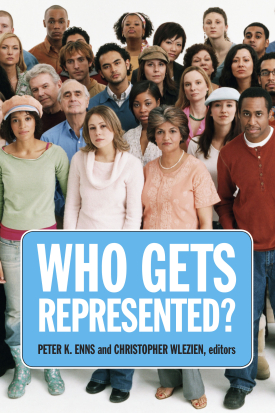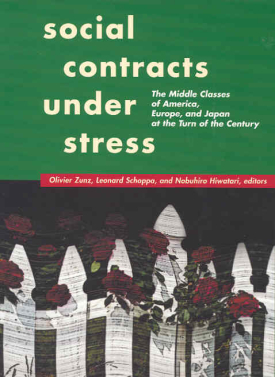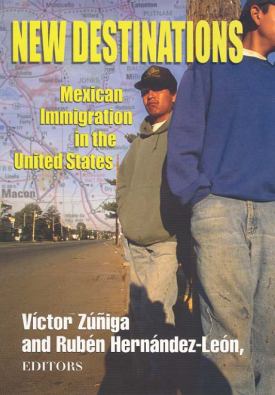Household survey responses rates in the United States have been steadily declining for at least the last two decades. A similar decline in survey response can be observed in all wealthy countries, and is particularly high in areas with large numbers of single-parent households, families with young children, workers with long commutes, and high crime rates. Efforts to raise response rates have used monetary incentives or repetitive attempts to obtain completed interviews, but these strategies increase the costs of surveys and are often unsuccessful.
The long-running rise in economic inequality in the U.S. is sometimes framed as a threat that the poor will fall further and further behind the rest of society. But in fact, most of the increase in inequality has occurred at the top of the distribution, not the bottom—it is more a matter of the rich pulling away from everyone else rather than the poor falling behind. And, within the high-income group, it is those at the very top who have made the biggest gains.
Since 2006, the last time Congress failed to pass comprehensive immigration reform, state and local authorities have increasingly taken immigration law and enforcement into their own hands. While these new regulations cover a broad spectrum of immigration reform, many are notable for their anti-immigrant leanings, including laws banning landlords from renting to undocumented immigrants and “English-only” ordinances.
Nearly a half century after the civil rights movement, race remains a significant predictor of income, wealth, employment, health, educational attainment, and a number of other social and economic outcomes. In all of these areas African Americans and other minorities lag behind whites, which poses serious issues not only for these group members but for the overall health of American democracy. While the existence of these racial disparities is well documented, the causes of their persistence remain a vexing puzzle.

Who Gets Represented?
About This Book
An investigation of policy preferences in the U.S. and how group opinion affects political representation.
While it is often assumed that policymakers favor the interests of some citizens at the expense of others, it is not always evident when and how groups’ interests differ or what it means when they do. Who Gets Represented? challenges the usual assumption that the preferences of any one group—women, African Americans, or the middle class—are incompatible with the preferences of other groups. The book analyzes differences across income, education, racial, and partisan groups and investigates whether and how differences in group opinion matter with regard to political representation.
Part I examines opinions among social and racial groups. Relying on an innovative matching technique, contributors Marisa Abrajano and Keith Poole link respondents in different surveys to show that racial and ethnic groups do not, as previously thought, predictably embrace similar attitudes about social welfare. Katherine Cramer Walsh finds that, although preferences on health care policy and government intervention are often surprisingly similar across class lines, different income groups can maintain the same policy preferences for different reasons. Part II turns to how group interests translate into policy outcomes, with a focus on differences in representation between income groups. James Druckman and Lawrence Jacobs analyze Ronald Reagan’s response to private polling data during his presidency and show how different electorally significant groups—Republicans, the wealthy, religious conservatives—wielded disproportionate influence on Reagan’s policy positions. Christopher Wlezien and Stuart Soroka show that politicians’ responsiveness to the preferences of constituents within different income groups can be surprisingly even-handed. Analyzing data from 1876 to the present, Wesley Hussey and John Zaller focus on the important role of political parties, vis-à-vis constituents’ preferences, for legislators’ behavior.
Who Gets Represented? upends several long-held assumptions, among them the growing conventional wisdom that income plays in American politics and the assumption that certain groups will always—or will never—have common interests. Similarities among group opinions are as significant as differences for understanding political representation. Who Gets Represented? offers important and surprising answers
to the question it raises.
PETER K. ENNS is assistant professor of government at Cornell University.
CHRISTOPHER WLEZIEN is professor of political science at Temple University.
CONTRIBUTORS: Marisa Abrajano, Yosef Bhatti, James N. Druckman, Christopher Ellis, Robert S. Erikson, Martin Gilens, David A. Hopkins, Wesley Hussey, Lawrence R. Jacobs, Keith T. Poole, Elizabeth Rigby, Stuart N. Soroka, James A. Stimson, Laura Stoker, Joseph Daniel Ura, Katherine Cramer Walsh, Gerald C. Wright, John Zaller.
Related Events & Media
RSF Journal
View Book Series
Sign Up For Our Mailing List
Apply For Funding

Social Contracts Under Stress
About This Book
The years following World War II saw a huge expansion of the middle classes in the world's industrialized nations, with a significant part of the working class becoming absorbed into the middle class. Although never explicitly formalized, it was as though a new social contract called for government, business, and labor to work together to ensure greater political freedom and more broadly shared economic prosperity. For the most part, they succeeded. In Social Contracts Under Stress, eighteen experts from seven countries examine this historic transformation and look ahead to assess how the middle class might fare in the face of slowing economic growth and increasing globalization.
The first section of the book focuses on the differing experiences of Germany, Britain, France, the United States, and Japan as they became middle-class societies. The British working classes, for example, were slowest to consider themselves middle class, while in Japan by the 1960s, most workers had abandoned working-class identity. The French remain more fragmented among various middle classes and resist one homogenous entity. Part II presents compelling evidence that the rise of a huge middle class was far from inclusive or free of social friction. Some contributors discuss how the social contract reinforced long-standing prejudices toward minorities and women. In the United States, Ira Katznelson writes, Southern politicians used measures that should have promoted equality, such as the GI bill, to exclude blacks from full access to opportunity. In her review of gender and family models, Chiara Saraceno finds that Mediterranean countries have mobilized the power of the state to maintain a division of labor between men and women. The final section examines what effect globalization might have on the middle class. Leonard Schoppa's careful analysis of the relevant data shows how globalization has pushed "less skilled workers down and more skilled workers up out of a middle class that had for a few decades been home to both." Although Europe has resisted the rise of inequality more effectively than the United States or Japan, several contributors wonder how long that resistance can last.
Social Contracts Under Stress argues convincingly that keeping the middle class open and inclusive in the face of current economic pressures will require a collective will extending across countries. This book provides an invaluable guide for assessing the issues that must be considered in such an effort.
OLIVIER ZUNZ is Commonwealth Professor of History, University of Virginia.
LEONARD SCHOPPA is associate professor in the Woodrow Wilson Department of Government and Foreign Affairs, University of Virginia.
NOBUHIRO HIWATARI is professor of political science at the University of Tokyo.
Download
RSF Journal
View Book Series
Sign Up For Our Mailing List
Apply For Funding

New Destinations
About This Book
Mexican immigration to the United States—the oldest and largest immigration movement to this country—is in the midst of a fundamental transformation. For decades, Mexican immigration was primarily a border phenomenon, confined to Southwestern states. But legal changes in the mid-1980s paved the way for Mexican migrants to settle in parts of America that had no previous exposure to people of Mexican heritage. In New Destinations, editors Víctor Zúñiga and Rubén Hernández-León bring together an inter-disciplinary team of scholars to examine demographic, social, cultural, and political changes in areas where the incorporation of Mexican migrants has deeply changed the preexisting ethnic landscape.
New Destinations looks at several of the communities where Mexican migrants are beginning to settle, and documents how the latest arrivals are reshaping—and being reshaped by—these new areas of settlement. Contributors Jorge Durand, Douglas Massey, and Chiara Capoferro use census data to diagram the historical evolution of Mexican immigration to the United States, noting the demographic, economic, and legal factors that led recent immigrants to move to areas where few of their predecessors had settled. Looking at two towns in Southern Louisiana, contributors Katharine Donato, Melissa Stainback, and Carl Bankston III reach a surprising conclusion: that documented immigrant workers did a poorer job of integrating into the local culture than their undocumented peers. They attribute this counterintuitive finding to documentation policies, which helped intensify employer control over migrants and undercut the formation of a stable migrant community among documented workers. Brian Rich and Marta Miranda detail an ambivalent mixture of paternalism and xenophobia by local residents toward migrants in Lexington, Kentucky. The new arrivals were welcomed for their strong work ethic so long as they stayed in “invisible” spheres such as fieldwork, but were resented once they began to take part in more public activities like schools or town meetings. New Destinations also provides some hopeful examples of progress in community relations. Several chapters, including Mark Grey and Anne Woodrick’s examination of a small Iowa town, point to the importance of dialogue and mediation in establishing amicable relations between ethnic groups in newly multi-cultural settings.
New Destinations is the first scholarly assessment of Mexican migrants’ experience in the Midwest, Northeast, and deep South—the latest settlement points for America’s largest immigrant group. Enriched by perspectives from demographers, anthropologists, sociologists, folklorists, and political scientists, this volume is an essential starting point for scholarship on the new Mexican migration.
VÍCTOR ZÚÑIGA is dean of the School of Education and Humanities at the Universidad de Monterrey.
RUBÉN HERNÁNDEZ-LEÓN is assistant professor of sociology at the University of California at Los Angeles.
CONTRIBUTORS: Ana Maria Aragones, Carl L. Bankston III, Chiara Capoferro, Miguel A. Carranza, Jasney Cogua, Katharine M. Donato, Timothy J. Dunn, Jorge Durand, Lourdes Gouveia, Mark A. Grey, David C. Griffith, Douglas S. Massey, Marta Miranda, Brian L. Rich, George Shivers, Debra Lattanzi Shutika, Robert Courtney Smith, Melissa Stainback, Anne C. Woodrick.
RSF Journal
View Book Series
Sign Up For Our Mailing List
Apply For Funding
Pagination
- Previous page
- Page 30
- Next page
